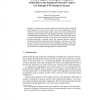Free Online Productivity Tools
i2Speak
i2Symbol
i2OCR
iTex2Img
iWeb2Print
iWeb2Shot
i2Type
iPdf2Split
iPdf2Merge
i2Bopomofo
i2Arabic
i2Style
i2Image
i2PDF
iLatex2Rtf
Sci2ools
MLMI
2004
Springer
2004
Springer
A Mixed-Lingual Phonological Component Which Drives the Statistical Prosody Control of a Polyglot TTS Synthesis System
A polyglot text-to-speech synthesis system which is able to read aloud mixed-lingual text has first of all to derive the correct pronunciation. This is achieved with an accurate morpho-syntactic analyzer that works simultaneously as language detector, followed by a phonological component which performs various phonological transformations. The result of these symbol processing steps is a complete phonological description of the speech to be synthesized. The subsequent processing step, i.e. prosody control, has to generate numerical values for the physical prosodic parameters from this description, a task that is very different from the former ones. This article shows appropriate solutions to both types of tasks, namely a particular rule-based approach for the phonological component and a statistical or machine learning approach to prosody control.
| Added | 02 Jul 2010 |
| Updated | 02 Jul 2010 |
| Type | Conference |
| Year | 2004 |
| Where | MLMI |
| Authors | Harald Romsdorfer, Beat Pfister, René Beutler |
Comments (0)

